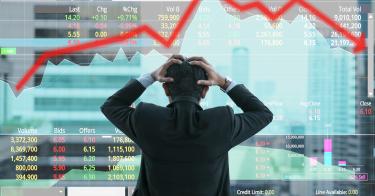For over a year, the Federal Reserve ignored myriad warning signs and continued injecting money into the economy. The result was the appearance of robust economic growth and a surge in demand, especially in the labor market, which ushered in decades-high inflation. But as the Fed belatedly raises rates, the veil is falling, and financial markets with it.
Oscar Wilde’s "The Picture of Dorian Gray" offers a striking parallel to our situation. The novel’s eponymous protagonist has a portrait that ages and decays while he remains youthful and vibrant. But his health is an illusion, while his portrait—hidden from view—contains the truth.
The massive liquidity infusions by the Fed have created a mirage of economic health. Large nominal gains in corporate earnings, asset values and even wages made the economy appear healthy. But after adjusting for the inflation caused by creating too much money, these economic figures are at best disappointing and at worst negative.
That adjustment for inflation is the real picture of the economy, much like the portrait of Dorian Gray. It lays bare all the sins of the past. As evidence, in the first quarter of this year, the economy nominally grew at a robust 6.5 percent annual rate, but after adjusting for inflation, it really fell by 1.4 percent.
>>> Monetary Malpractice at the Federal Reserve
As reality sets in across financial markets, investors continue their selloff. Equities continue to fall, with stocks experiencing the most consecutive weeks in the red since the Great Depression and seeing their worst losses since the panic-induced selloff at the beginning of the pandemic.
Inflation has robbed consumers of their purchasing power, causing savings to be depleted, consumer debt to increase, and future spending projections to precipitously drop. It turns out corporate earnings will not continue rising ad infinitum as the Fed’s sins have now at last caught up with everyone.
Creating trillions of dollars out of thin air certainly provides a temporary boost to the economy. But that easy money and cheap credit creates an addiction with painful withdrawal symptoms, which the nation is experiencing right now as markets are brought face-to-face with the real portrait of the economy. This merely exacerbates the boom-bust cycle instead of smoothing it out.
Since the Fed cannot actually create growth, let alone wealth, the best it can do is play the man behind the curtain, creating the chimera of money-fueled growth in place of the real McCoy. That is precisely what we have seen for the last year and a half -- what might be dubbed the economy of Dorian Gray. In its errant quest to support the appearance of growth, the Fed set the real economy up for disaster.
The Fed’s excuse for fueling this inflation over the last 18 months has been its “dual mandate,” under which it aims to simultaneously maintain stable prices and the amorphous target of full employment. Flooding the financial markets with liquidity for more than a year made for a seemingly robust labor market, creating so much labor demand that unfilled jobs are at a record-high 11.5 million and nominal wages are rising fast.
>>> Three Things Congress Can Do To Get Serious on Inflation
However, just like other sectors of the economy, the real labor market is not as healthy as it appears. Prices are rising faster than wages, making workers demonstrably worse off today than they were 18 months ago.
And as it created extraordinary quantities of money to support full employment, the Fed effectively served as the implicit financing arm of a Congress that recklessly shirked its fiscal duties and relied on the hidden tax of inflation to pay for trillions of dollars in unfunded spending.
For those who previously sounded the alarm on this inflationary incubus, it is a hollow victory. There is no joy in seeing the fruition of impolitic policies impoverishing one’s fellow citizens. But the reality is that these effects have been hidden for years in a portrait out of public view.
This piece originally appeared in The Sacramento Bee




